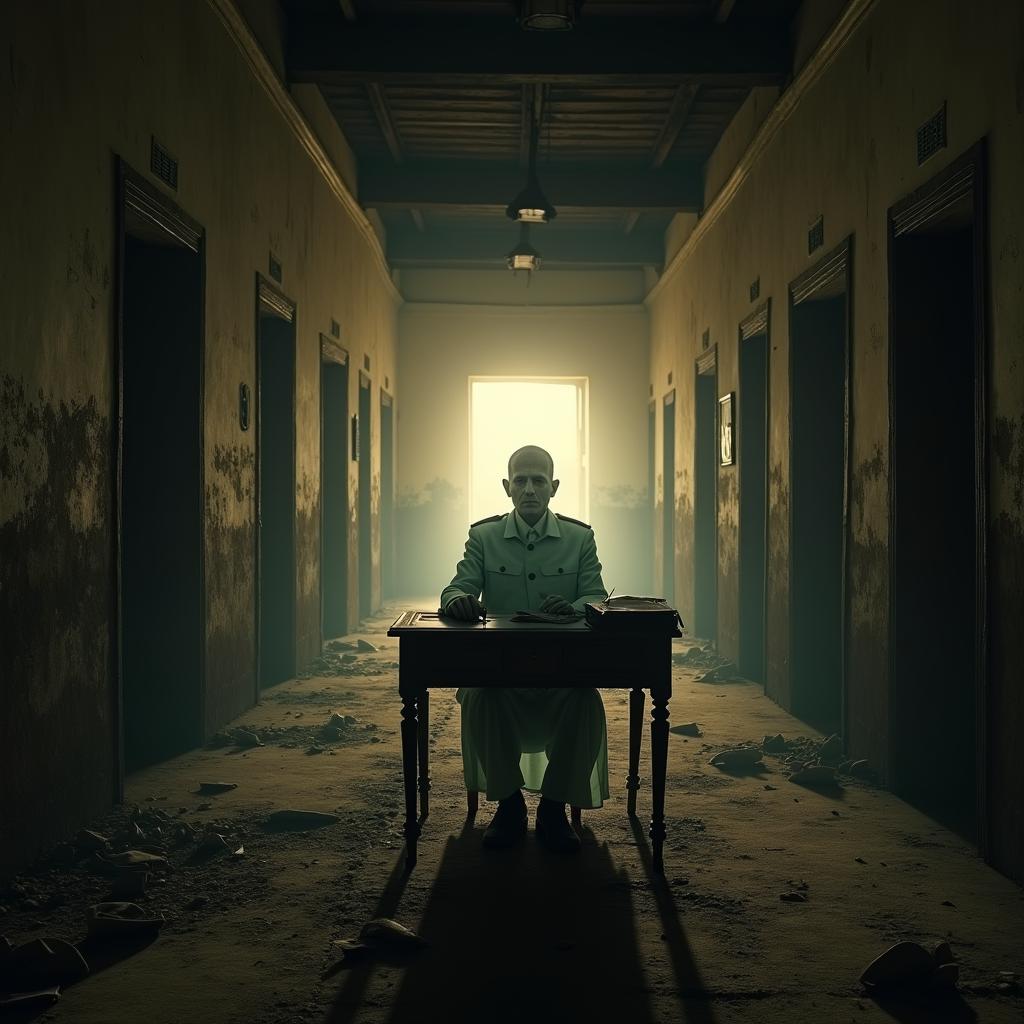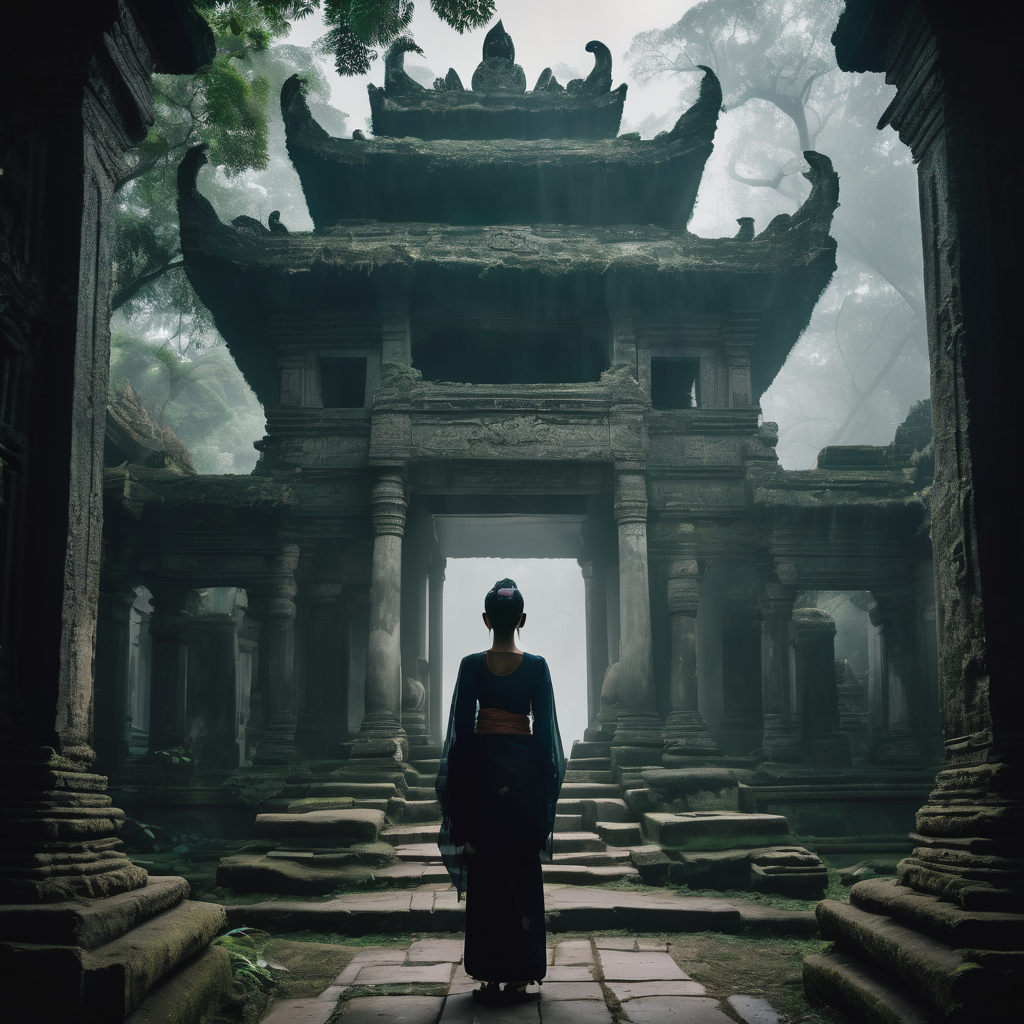The sun was setting over Semarang, casting long shadows across the imposing brick walls of Lawang Sewu – a building that had witnessed more tragedy than most could imagine. As a travel photographer, I’d heard countless stories about this historical landmark, but nothing could prepare me for the chilling encounter that awaited me that evening.
The building stood as a silent testament to Indonesia’s complex colonial history, its countless doors earning it the nickname “Thousand Doors.” Originally constructed as the headquarters for the Dutch East Indies Railway Company, Lawang Sewu had transformed from an administrative marvel to a dark symbol of wartime suffering. During World War II, the Japanese occupation turned these elegant corridors into a nightmare of torture and despair, with the basement becoming a chamber of unimaginable horror.
Our tour group moved slowly through the decaying hallways, the guide’s voice echoing with historical details that sent subtle shivers down my spine. He spoke of the building’s dark past – how hundreds of prisoners were interrogated, tortured, and killed within these very walls. The afternoon light filtered through broken windows, creating strange shadows that seemed to dance with memories of the past. As the group began to disperse, I lingered behind, my camera capturing the intricate architectural details.
![attachment"><a href=\'https://relak.la/wp-content/uploads/2025/03/the-haunting-silence.jpg\'><img loading="lazy" decoding="async" width="300" height="300" src="https://relak.la/wp-content/uploads/2025/03/the-haunting-silence-300x300.jpg" class="attachment-medium size-medium" alt="" srcset="https://relak.la/wp-content/uploads/2025/03/the-haunting-silence-300x300.jpg 300w, https://relak.la/wp-content/uploads/2025/03/the-haunting-silence-150x150.jpg 150w, https://relak.la/wp-content/uploads/2025/03/the-haunting-silence-768x768.jpg 768w, https://relak.la/wp-content/uploads/2025/03/the-haunting-silence-420x420.jpg 420w, https://relak.la/wp-content/uploads/2025/03/the-haunting-silence-696x696.jpg 696w, https://relak.la/wp-content/uploads/2025/03/the-haunting-silence.jpg 1024w" sizes="auto, (max-width: 300px) 100vw, 300px" /></a></p>\n'}, 'caption': {'raw': '', 'rendered': ''}, 'alt_text': '', 'media_type': 'image', 'mime_type': 'image/jpeg', 'media_details': {'width': 1024, 'height': 1024, 'file': '2025/03/the-haunting-silence.jpg', 'filesize': 48572, 'sizes': {'medium': {'file': 'the-haunting-silence-300x300.jpg', 'width': 300, 'height': 300, 'filesize': 6571, 'mime_type': 'image/jpeg', 'source_url': 'https://relak.la/wp-content/uploads/2025/03/the-haunting-silence-300x300.jpg'}, 'thumbnail': {'file': 'the-haunting-silence-150x150.jpg', 'width': 150, 'height': 150, 'filesize': 2569, 'mime_type': 'image/jpeg', 'source_url': 'https://relak.la/wp-content/uploads/2025/03/the-haunting-silence-150x150.jpg'}, 'medium_large': {'file': 'the-haunting-silence-768x768.jpg', 'width': 768, 'height': 768, 'filesize': 32250, 'mime_type': 'image/jpeg', 'source_url': 'https://relak.la/wp-content/uploads/2025/03/the-haunting-silence-768x768.jpg'}, 'td_0x420': {'file': 'the-haunting-silence-420x420.jpg', 'width': 420, 'height': 420, 'filesize': 11243, 'mime_type': 'image/jpeg', 'source_url': 'https://relak.la/wp-content/uploads/2025/03/the-haunting-silence-420x420.jpg'}, 'td_80x60': {'file': 'the-haunting-silence-80x60.jpg', 'width': 80, 'height': 60, 'filesize': 1229, 'mime_type': 'image/jpeg', 'source_url': 'https://relak.la/wp-content/uploads/2025/03/the-haunting-silence-80x60.jpg'}, 'td_150x0': {'file': 'the-haunting-silence-150x150.jpg', 'width': 150, 'height': 150, 'filesize': 2569, 'mime_type': 'image/jpeg', 'source_url': 'https://relak.la/wp-content/uploads/2025/03/the-haunting-silence-150x150.jpg'}, 'td_218x150': {'file': 'the-haunting-silence-218x150.jpg', 'width': 218, 'height': 150, 'filesize': 2920, 'mime_type': 'image/jpeg', 'source_url': 'https://relak.la/wp-content/uploads/2025/03/the-haunting-silence-218x150.jpg'}, 'td_300x0': {'file': 'the-haunting-silence-300x300.jpg', 'width': 300, 'height': 300, 'filesize': 6571, 'mime_type': 'image/jpeg', 'source_url': 'https://relak.la/wp-content/uploads/2025/03/the-haunting-silence-300x300.jpg'}, 'td_324x400': {'file': 'the-haunting-silence-324x400.jpg', 'width': 324, 'height': 400, 'filesize': 9565, 'mime_type': 'image/jpeg', 'source_url': 'https://relak.la/wp-content/uploads/2025/03/the-haunting-silence-324x400.jpg'}, 'td_485x360': {'file': 'the-haunting-silence-485x360.jpg', 'width': 485, 'height': 360, 'filesize': 10029, 'mime_type': 'image/jpeg', 'source_url': 'https://relak.la/wp-content/uploads/2025/03/the-haunting-silence-485x360.jpg'}, 'td_696x0': {'file': 'the-haunting-silence-696x696.jpg', 'width': 696, 'height': 696, 'filesize': 26868, 'mime_type': 'image/jpeg', 'source_url': 'https://relak.la/wp-content/uploads/2025/03/the-haunting-silence-696x696.jpg'}, 'full': {'file': 'the-haunting-silence.jpg', 'width': 1024, 'height': 1024, 'mime_type': 'image/jpeg', 'source_url': 'https://relak.la/wp-content/uploads/2025/03/the-haunting-silence.jpg'}}, 'image_meta': {'aperture': '0', 'credit': '', 'camera': '', 'caption': '', 'created_timestamp': '0', 'copyright': '', 'focal_length': '0', 'iso': '0', 'shutter_speed': '0', 'title': '', 'orientation': '0', 'keywords': []}}, 'post': None, 'source_url': 'https://relak.la/wp-content/uploads/2025/03/the-haunting-silence.jpg', 'missing_image_sizes': [], '_links': {'self': [{'href': 'https://relak.la/wp-json/wp/v2/media/3269', 'targetHints': {'allow': ['GET', 'POST', 'PUT', 'PATCH', 'DELETE']}}], 'collection': [{'href': 'https://relak.la/wp-json/wp/v2/media'}], 'about': [{'href': 'https://relak.la/wp-json/wp/v2/types/attachment'}], 'author': [{'embeddable': True, 'href': 'https://relak.la/wp-json/wp/v2/users/2'}], 'replies': [{'embeddable': True, 'href': 'https://relak.la/wp-json/wp/v2/comments?post=3269'}], 'wp:action-unfiltered-html': [{'href': 'https://relak.la/wp-json/wp/v2/media/3269'}], 'wp:action-assign-author': [{'href': 'https://relak.la/wp-json/wp/v2/media/3269'}], 'curies': [{'name': 'wp', 'href': 'https://api.w.org/{rel}', 'templated': True}]}} "The Haunting Silence An eerie corridor with closing doors and chilling silence.]({'id': 3269, 'date': '2025-03-27T19:47:46', 'date_gmt': '2025-03-27T11:47:46', 'guid': {'rendered': 'https://relak.la/wp-content/uploads/2025/03/the-haunting-silence.jpg', 'raw': 'https://relak.la/wp-content/uploads/2025/03/the-haunting-silence.jpg'}, 'modified': '2025-03-27T19:47:46', 'modified_gmt': '2025-03-27T11:47:46', 'slug': 'the-haunting-silence', 'status': 'inherit', 'type': 'attachment', 'link': 'https://relak.la/the-haunting-silence/', 'title': {'raw': 'the-haunting-silence', 'rendered': 'the-haunting-silence'}, 'author': 2, 'featured_media': 0, 'comment_status': 'open', 'ping_status': 'closed', 'template': '', 'meta': [], 'permalink_template': 'https://relak.la/?attachment_id=3269', 'generated_slug': 'the-haunting-silence', 'class_list': ['post-3269', 'attachment', 'type-attachment', 'status-inherit'], 'description': {'raw': '', 'rendered': '<p class=)
Suddenly, the atmosphere changed. The temperature dropped dramatically, and an unnatural silence descended upon the corridor. Doors began to close independently, their wooden frames creaking with a sound that felt more like a whisper than a movement. My breath caught in my throat as I realized I was completely alone in a section of the building untouched by the remaining tour group.
In one of the rooms, impossibly preserved against the building’s decay, I saw something that defied explanation. A Dutch colonial officer sat at an antique desk, his figure crisp and clear against the fading light. As he slowly turned, I realized with horror that his body bore the unmistakable marks of extreme torture – deep wounds that seemed to pulse with an otherworldly pain. Surrounding him, multiple apparitions began to materialize in doorways, their forms translucent yet horrifyingly detailed.
![attachment"><a href=\'https://relak.la/wp-content/uploads/2025/03/wartime-chaos-unleashed.jpg\'><img loading="lazy" decoding="async" width="300" height="300" src="https://relak.la/wp-content/uploads/2025/03/wartime-chaos-unleashed-300x300.jpg" class="attachment-medium size-medium" alt="" srcset="https://relak.la/wp-content/uploads/2025/03/wartime-chaos-unleashed-300x300.jpg 300w, https://relak.la/wp-content/uploads/2025/03/wartime-chaos-unleashed-150x150.jpg 150w, https://relak.la/wp-content/uploads/2025/03/wartime-chaos-unleashed-768x768.jpg 768w, https://relak.la/wp-content/uploads/2025/03/wartime-chaos-unleashed-420x420.jpg 420w, https://relak.la/wp-content/uploads/2025/03/wartime-chaos-unleashed-696x696.jpg 696w, https://relak.la/wp-content/uploads/2025/03/wartime-chaos-unleashed.jpg 1024w" sizes="auto, (max-width: 300px) 100vw, 300px" /></a></p>\n'}, 'caption': {'raw': '', 'rendered': ''}, 'alt_text': '', 'media_type': 'image', 'mime_type': 'image/jpeg', 'media_details': {'width': 1024, 'height': 1024, 'file': '2025/03/wartime-chaos-unleashed.jpg', 'filesize': 81327, 'sizes': {'medium': {'file': 'wartime-chaos-unleashed-300x300.jpg', 'width': 300, 'height': 300, 'filesize': 11125, 'mime_type': 'image/jpeg', 'source_url': 'https://relak.la/wp-content/uploads/2025/03/wartime-chaos-unleashed-300x300.jpg'}, 'thumbnail': {'file': 'wartime-chaos-unleashed-150x150.jpg', 'width': 150, 'height': 150, 'filesize': 3963, 'mime_type': 'image/jpeg', 'source_url': 'https://relak.la/wp-content/uploads/2025/03/wartime-chaos-unleashed-150x150.jpg'}, 'medium_large': {'file': 'wartime-chaos-unleashed-768x768.jpg', 'width': 768, 'height': 768, 'filesize': 54076, 'mime_type': 'image/jpeg', 'source_url': 'https://relak.la/wp-content/uploads/2025/03/wartime-chaos-unleashed-768x768.jpg'}, 'td_0x420': {'file': 'wartime-chaos-unleashed-420x420.jpg', 'width': 420, 'height': 420, 'filesize': 19466, 'mime_type': 'image/jpeg', 'source_url': 'https://relak.la/wp-content/uploads/2025/03/wartime-chaos-unleashed-420x420.jpg'}, 'td_80x60': {'file': 'wartime-chaos-unleashed-80x60.jpg', 'width': 80, 'height': 60, 'filesize': 1583, 'mime_type': 'image/jpeg', 'source_url': 'https://relak.la/wp-content/uploads/2025/03/wartime-chaos-unleashed-80x60.jpg'}, 'td_150x0': {'file': 'wartime-chaos-unleashed-150x150.jpg', 'width': 150, 'height': 150, 'filesize': 3963, 'mime_type': 'image/jpeg', 'source_url': 'https://relak.la/wp-content/uploads/2025/03/wartime-chaos-unleashed-150x150.jpg'}, 'td_218x150': {'file': 'wartime-chaos-unleashed-218x150.jpg', 'width': 218, 'height': 150, 'filesize': 4984, 'mime_type': 'image/jpeg', 'source_url': 'https://relak.la/wp-content/uploads/2025/03/wartime-chaos-unleashed-218x150.jpg'}, 'td_300x0': {'file': 'wartime-chaos-unleashed-300x300.jpg', 'width': 300, 'height': 300, 'filesize': 11125, 'mime_type': 'image/jpeg', 'source_url': 'https://relak.la/wp-content/uploads/2025/03/wartime-chaos-unleashed-300x300.jpg'}, 'td_324x400': {'file': 'wartime-chaos-unleashed-324x400.jpg', 'width': 324, 'height': 400, 'filesize': 16008, 'mime_type': 'image/jpeg', 'source_url': 'https://relak.la/wp-content/uploads/2025/03/wartime-chaos-unleashed-324x400.jpg'}, 'td_485x360': {'file': 'wartime-chaos-unleashed-485x360.jpg', 'width': 485, 'height': 360, 'filesize': 17778, 'mime_type': 'image/jpeg', 'source_url': 'https://relak.la/wp-content/uploads/2025/03/wartime-chaos-unleashed-485x360.jpg'}, 'td_696x0': {'file': 'wartime-chaos-unleashed-696x696.jpg', 'width': 696, 'height': 696, 'filesize': 46016, 'mime_type': 'image/jpeg', 'source_url': 'https://relak.la/wp-content/uploads/2025/03/wartime-chaos-unleashed-696x696.jpg'}, 'full': {'file': 'wartime-chaos-unleashed.jpg', 'width': 1024, 'height': 1024, 'mime_type': 'image/jpeg', 'source_url': 'https://relak.la/wp-content/uploads/2025/03/wartime-chaos-unleashed.jpg'}}, 'image_meta': {'aperture': '0', 'credit': '', 'camera': '', 'caption': '', 'created_timestamp': '0', 'copyright': '', 'focal_length': '0', 'iso': '0', 'shutter_speed': '0', 'title': '', 'orientation': '0', 'keywords': []}}, 'post': None, 'source_url': 'https://relak.la/wp-content/uploads/2025/03/wartime-chaos-unleashed.jpg', 'missing_image_sizes': [], '_links': {'self': [{'href': 'https://relak.la/wp-json/wp/v2/media/3270', 'targetHints': {'allow': ['GET', 'POST', 'PUT', 'PATCH', 'DELETE']}}], 'collection': [{'href': 'https://relak.la/wp-json/wp/v2/media'}], 'about': [{'href': 'https://relak.la/wp-json/wp/v2/types/attachment'}], 'author': [{'embeddable': True, 'href': 'https://relak.la/wp-json/wp/v2/users/2'}], 'replies': [{'embeddable': True, 'href': 'https://relak.la/wp-json/wp/v2/comments?post=3270'}], 'wp:action-unfiltered-html': [{'href': 'https://relak.la/wp-json/wp/v2/media/3270'}], 'wp:action-assign-author': [{'href': 'https://relak.la/wp-json/wp/v2/media/3270'}], 'curies': [{'name': 'wp', 'href': 'https://api.w.org/{rel}', 'templated': True}]}} "Wartime Chaos Unleashed The chaotic aftermath of wartime within the darkened corridors.]({'id': 3270, 'date': '2025-03-27T19:50:16', 'date_gmt': '2025-03-27T11:50:16', 'guid': {'rendered': 'https://relak.la/wp-content/uploads/2025/03/wartime-chaos-unleashed.jpg', 'raw': 'https://relak.la/wp-content/uploads/2025/03/wartime-chaos-unleashed.jpg'}, 'modified': '2025-03-27T19:50:16', 'modified_gmt': '2025-03-27T11:50:16', 'slug': 'wartime-chaos-unleashed', 'status': 'inherit', 'type': 'attachment', 'link': 'https://relak.la/wartime-chaos-unleashed/', 'title': {'raw': 'wartime-chaos-unleashed', 'rendered': 'wartime-chaos-unleashed'}, 'author': 2, 'featured_media': 0, 'comment_status': 'open', 'ping_status': 'closed', 'template': '', 'meta': [], 'permalink_template': 'https://relak.la/?attachment_id=3270', 'generated_slug': 'wartime-chaos-unleashed', 'class_list': ['post-3270', 'attachment', 'type-attachment', 'status-inherit'], 'description': {'raw': '', 'rendered': '<p class=)
Panic seized me as the spirits seemed to close in, the sounds of wartime chaos erupting around me – distant screams, metal clanging, and whispered pleas in Dutch and Japanese. The corridors twisted impossibly, doors opening and closing with a rhythm that felt alive. Each step I took seemed to lead me deeper into a nightmare from which escape seemed impossible.
![attachment"><a href=\'https://relak.la/wp-content/uploads/2025/03/guardian-of-the-haunted.jpg\'><img loading="lazy" decoding="async" width="300" height="300" src="https://relak.la/wp-content/uploads/2025/03/guardian-of-the-haunted-300x300.jpg" class="attachment-medium size-medium" alt="" srcset="https://relak.la/wp-content/uploads/2025/03/guardian-of-the-haunted-300x300.jpg 300w, https://relak.la/wp-content/uploads/2025/03/guardian-of-the-haunted-150x150.jpg 150w, https://relak.la/wp-content/uploads/2025/03/guardian-of-the-haunted-768x768.jpg 768w, https://relak.la/wp-content/uploads/2025/03/guardian-of-the-haunted-420x420.jpg 420w, https://relak.la/wp-content/uploads/2025/03/guardian-of-the-haunted-696x696.jpg 696w, https://relak.la/wp-content/uploads/2025/03/guardian-of-the-haunted.jpg 1024w" sizes="auto, (max-width: 300px) 100vw, 300px" /></a></p>\n'}, 'caption': {'raw': '', 'rendered': ''}, 'alt_text': '', 'media_type': 'image', 'mime_type': 'image/jpeg', 'media_details': {'width': 1024, 'height': 1024, 'file': '2025/03/guardian-of-the-haunted.jpg', 'filesize': 57936, 'sizes': {'medium': {'file': 'guardian-of-the-haunted-300x300.jpg', 'width': 300, 'height': 300, 'filesize': 10401, 'mime_type': 'image/jpeg', 'source_url': 'https://relak.la/wp-content/uploads/2025/03/guardian-of-the-haunted-300x300.jpg'}, 'thumbnail': {'file': 'guardian-of-the-haunted-150x150.jpg', 'width': 150, 'height': 150, 'filesize': 4066, 'mime_type': 'image/jpeg', 'source_url': 'https://relak.la/wp-content/uploads/2025/03/guardian-of-the-haunted-150x150.jpg'}, 'medium_large': {'file': 'guardian-of-the-haunted-768x768.jpg', 'width': 768, 'height': 768, 'filesize': 42494, 'mime_type': 'image/jpeg', 'source_url': 'https://relak.la/wp-content/uploads/2025/03/guardian-of-the-haunted-768x768.jpg'}, 'td_0x420': {'file': 'guardian-of-the-haunted-420x420.jpg', 'width': 420, 'height': 420, 'filesize': 17164, 'mime_type': 'image/jpeg', 'source_url': 'https://relak.la/wp-content/uploads/2025/03/guardian-of-the-haunted-420x420.jpg'}, 'td_80x60': {'file': 'guardian-of-the-haunted-80x60.jpg', 'width': 80, 'height': 60, 'filesize': 1709, 'mime_type': 'image/jpeg', 'source_url': 'https://relak.la/wp-content/uploads/2025/03/guardian-of-the-haunted-80x60.jpg'}, 'td_150x0': {'file': 'guardian-of-the-haunted-150x150.jpg', 'width': 150, 'height': 150, 'filesize': 4066, 'mime_type': 'image/jpeg', 'source_url': 'https://relak.la/wp-content/uploads/2025/03/guardian-of-the-haunted-150x150.jpg'}, 'td_218x150': {'file': 'guardian-of-the-haunted-218x150.jpg', 'width': 218, 'height': 150, 'filesize': 4946, 'mime_type': 'image/jpeg', 'source_url': 'https://relak.la/wp-content/uploads/2025/03/guardian-of-the-haunted-218x150.jpg'}, 'td_300x0': {'file': 'guardian-of-the-haunted-300x300.jpg', 'width': 300, 'height': 300, 'filesize': 10401, 'mime_type': 'image/jpeg', 'source_url': 'https://relak.la/wp-content/uploads/2025/03/guardian-of-the-haunted-300x300.jpg'}, 'td_324x400': {'file': 'guardian-of-the-haunted-324x400.jpg', 'width': 324, 'height': 400, 'filesize': 13586, 'mime_type': 'image/jpeg', 'source_url': 'https://relak.la/wp-content/uploads/2025/03/guardian-of-the-haunted-324x400.jpg'}, 'td_485x360': {'file': 'guardian-of-the-haunted-485x360.jpg', 'width': 485, 'height': 360, 'filesize': 15672, 'mime_type': 'image/jpeg', 'source_url': 'https://relak.la/wp-content/uploads/2025/03/guardian-of-the-haunted-485x360.jpg'}, 'td_696x0': {'file': 'guardian-of-the-haunted-696x696.jpg', 'width': 696, 'height': 696, 'filesize': 36518, 'mime_type': 'image/jpeg', 'source_url': 'https://relak.la/wp-content/uploads/2025/03/guardian-of-the-haunted-696x696.jpg'}, 'full': {'file': 'guardian-of-the-haunted.jpg', 'width': 1024, 'height': 1024, 'mime_type': 'image/jpeg', 'source_url': 'https://relak.la/wp-content/uploads/2025/03/guardian-of-the-haunted.jpg'}}, 'image_meta': {'aperture': '0', 'credit': '', 'camera': '', 'caption': '', 'created_timestamp': '0', 'copyright': '', 'focal_length': '0', 'iso': '0', 'shutter_speed': '0', 'title': '', 'orientation': '0', 'keywords': []}}, 'post': None, 'source_url': 'https://relak.la/wp-content/uploads/2025/03/guardian-of-the-haunted.jpg', 'missing_image_sizes': [], '_links': {'self': [{'href': 'https://relak.la/wp-json/wp/v2/media/3271', 'targetHints': {'allow': ['GET', 'POST', 'PUT', 'PATCH', 'DELETE']}}], 'collection': [{'href': 'https://relak.la/wp-json/wp/v2/media'}], 'about': [{'href': 'https://relak.la/wp-json/wp/v2/types/attachment'}], 'author': [{'embeddable': True, 'href': 'https://relak.la/wp-json/wp/v2/users/2'}], 'replies': [{'embeddable': True, 'href': 'https://relak.la/wp-json/wp/v2/comments?post=3271'}], 'wp:action-unfiltered-html': [{'href': 'https://relak.la/wp-json/wp/v2/media/3271'}], 'wp:action-assign-author': [{'href': 'https://relak.la/wp-json/wp/v2/media/3271'}], 'curies': [{'name': 'wp', 'href': 'https://api.w.org/{rel}', 'templated': True}]}} "Guardian of the Haunted A calm security guard amidst the chaos, conveying the ongoing hauntings.]({'id': 3271, 'date': '2025-03-27T19:51:52', 'date_gmt': '2025-03-27T11:51:52', 'guid': {'rendered': 'https://relak.la/wp-content/uploads/2025/03/guardian-of-the-haunted.jpg', 'raw': 'https://relak.la/wp-content/uploads/2025/03/guardian-of-the-haunted.jpg'}, 'modified': '2025-03-27T19:51:52', 'modified_gmt': '2025-03-27T11:51:52', 'slug': 'guardian-of-the-haunted', 'status': 'inherit', 'type': 'attachment', 'link': 'https://relak.la/guardian-of-the-haunted/', 'title': {'raw': 'guardian-of-the-haunted', 'rendered': 'guardian-of-the-haunted'}, 'author': 2, 'featured_media': 0, 'comment_status': 'open', 'ping_status': 'closed', 'template': '', 'meta': [], 'permalink_template': 'https://relak.la/?attachment_id=3271', 'generated_slug': 'guardian-of-the-haunted', 'class_list': ['post-3271', 'attachment', 'type-attachment', 'status-inherit'], 'description': {'raw': '', 'rendered': '<p class=)
Just as I thought all hope was lost, a security guard appeared, his calm demeanor cutting through the supernatural chaos. “They often come out at sunset,” he said matter-of-factly. He explained that his family had worked at Lawang Sewu for generations, and monthly offerings were still made to appease the spirits trapped within these walls. The building, he said, would never truly be at peace.
![attachment"><a href=\'https://relak.la/wp-content/uploads/2025/03/lawang-sewu-at-night.jpg\'><img loading="lazy" decoding="async" width="300" height="300" src="https://relak.la/wp-content/uploads/2025/03/lawang-sewu-at-night-300x300.jpg" class="attachment-medium size-medium" alt="" srcset="https://relak.la/wp-content/uploads/2025/03/lawang-sewu-at-night-300x300.jpg 300w, https://relak.la/wp-content/uploads/2025/03/lawang-sewu-at-night-150x150.jpg 150w, https://relak.la/wp-content/uploads/2025/03/lawang-sewu-at-night-768x768.jpg 768w, https://relak.la/wp-content/uploads/2025/03/lawang-sewu-at-night-420x420.jpg 420w, https://relak.la/wp-content/uploads/2025/03/lawang-sewu-at-night-696x696.jpg 696w, https://relak.la/wp-content/uploads/2025/03/lawang-sewu-at-night.jpg 1024w" sizes="auto, (max-width: 300px) 100vw, 300px" /></a></p>\n'}, 'caption': {'raw': '', 'rendered': ''}, 'alt_text': '', 'media_type': 'image', 'mime_type': 'image/jpeg', 'media_details': {'width': 1024, 'height': 1024, 'file': '2025/03/lawang-sewu-at-night.jpg', 'filesize': 33403, 'sizes': {'medium': {'file': 'lawang-sewu-at-night-300x300.jpg', 'width': 300, 'height': 300, 'filesize': 5834, 'mime_type': 'image/jpeg', 'source_url': 'https://relak.la/wp-content/uploads/2025/03/lawang-sewu-at-night-300x300.jpg'}, 'thumbnail': {'file': 'lawang-sewu-at-night-150x150.jpg', 'width': 150, 'height': 150, 'filesize': 2444, 'mime_type': 'image/jpeg', 'source_url': 'https://relak.la/wp-content/uploads/2025/03/lawang-sewu-at-night-150x150.jpg'}, 'medium_large': {'file': 'lawang-sewu-at-night-768x768.jpg', 'width': 768, 'height': 768, 'filesize': 24876, 'mime_type': 'image/jpeg', 'source_url': 'https://relak.la/wp-content/uploads/2025/03/lawang-sewu-at-night-768x768.jpg'}, 'td_0x420': {'file': 'lawang-sewu-at-night-420x420.jpg', 'width': 420, 'height': 420, 'filesize': 9764, 'mime_type': 'image/jpeg', 'source_url': 'https://relak.la/wp-content/uploads/2025/03/lawang-sewu-at-night-420x420.jpg'}, 'td_80x60': {'file': 'lawang-sewu-at-night-80x60.jpg', 'width': 80, 'height': 60, 'filesize': 1215, 'mime_type': 'image/jpeg', 'source_url': 'https://relak.la/wp-content/uploads/2025/03/lawang-sewu-at-night-80x60.jpg'}, 'td_150x0': {'file': 'lawang-sewu-at-night-150x150.jpg', 'width': 150, 'height': 150, 'filesize': 2444, 'mime_type': 'image/jpeg', 'source_url': 'https://relak.la/wp-content/uploads/2025/03/lawang-sewu-at-night-150x150.jpg'}, 'td_218x150': {'file': 'lawang-sewu-at-night-218x150.jpg', 'width': 218, 'height': 150, 'filesize': 2970, 'mime_type': 'image/jpeg', 'source_url': 'https://relak.la/wp-content/uploads/2025/03/lawang-sewu-at-night-218x150.jpg'}, 'td_300x0': {'file': 'lawang-sewu-at-night-300x300.jpg', 'width': 300, 'height': 300, 'filesize': 5834, 'mime_type': 'image/jpeg', 'source_url': 'https://relak.la/wp-content/uploads/2025/03/lawang-sewu-at-night-300x300.jpg'}, 'td_324x400': {'file': 'lawang-sewu-at-night-324x400.jpg', 'width': 324, 'height': 400, 'filesize': 7913, 'mime_type': 'image/jpeg', 'source_url': 'https://relak.la/wp-content/uploads/2025/03/lawang-sewu-at-night-324x400.jpg'}, 'td_485x360': {'file': 'lawang-sewu-at-night-485x360.jpg', 'width': 485, 'height': 360, 'filesize': 9259, 'mime_type': 'image/jpeg', 'source_url': 'https://relak.la/wp-content/uploads/2025/03/lawang-sewu-at-night-485x360.jpg'}, 'td_696x0': {'file': 'lawang-sewu-at-night-696x696.jpg', 'width': 696, 'height': 696, 'filesize': 21479, 'mime_type': 'image/jpeg', 'source_url': 'https://relak.la/wp-content/uploads/2025/03/lawang-sewu-at-night-696x696.jpg'}, 'full': {'file': 'lawang-sewu-at-night.jpg', 'width': 1024, 'height': 1024, 'mime_type': 'image/jpeg', 'source_url': 'https://relak.la/wp-content/uploads/2025/03/lawang-sewu-at-night.jpg'}}, 'image_meta': {'aperture': '0', 'credit': '', 'camera': '', 'caption': '', 'created_timestamp': '0', 'copyright': '', 'focal_length': '0', 'iso': '0', 'shutter_speed': '0', 'title': '', 'orientation': '0', 'keywords': []}}, 'post': None, 'source_url': 'https://relak.la/wp-content/uploads/2025/03/lawang-sewu-at-night.jpg', 'missing_image_sizes': [], '_links': {'self': [{'href': 'https://relak.la/wp-json/wp/v2/media/3272', 'targetHints': {'allow': ['GET', 'POST', 'PUT', 'PATCH', 'DELETE']}}], 'collection': [{'href': 'https://relak.la/wp-json/wp/v2/media'}], 'about': [{'href': 'https://relak.la/wp-json/wp/v2/types/attachment'}], 'author': [{'embeddable': True, 'href': 'https://relak.la/wp-json/wp/v2/users/2'}], 'replies': [{'embeddable': True, 'href': 'https://relak.la/wp-json/wp/v2/comments?post=3272'}], 'wp:action-unfiltered-html': [{'href': 'https://relak.la/wp-json/wp/v2/media/3272'}], 'wp:action-assign-author': [{'href': 'https://relak.la/wp-json/wp/v2/media/3272'}], 'curies': [{'name': 'wp', 'href': 'https://api.w.org/{rel}', 'templated': True}]}} "Lawang Sewu at Night The silent silhouette of Lawang Sewu under the night sky.]({'id': 3272, 'date': '2025-03-27T19:53:36', 'date_gmt': '2025-03-27T11:53:36', 'guid': {'rendered': 'https://relak.la/wp-content/uploads/2025/03/lawang-sewu-at-night.jpg', 'raw': 'https://relak.la/wp-content/uploads/2025/03/lawang-sewu-at-night.jpg'}, 'modified': '2025-03-27T19:53:36', 'modified_gmt': '2025-03-27T11:53:36', 'slug': 'lawang-sewu-at-night-2', 'status': 'inherit', 'type': 'attachment', 'link': 'https://relak.la/lawang-sewu-at-night-2/', 'title': {'raw': 'lawang-sewu-at-night', 'rendered': 'lawang-sewu-at-night'}, 'author': 2, 'featured_media': 0, 'comment_status': 'open', 'ping_status': 'closed', 'template': '', 'meta': [], 'permalink_template': 'https://relak.la/?attachment_id=3272', 'generated_slug': 'lawang-sewu-at-night-2', 'class_list': ['post-3272', 'attachment', 'type-attachment', 'status-inherit'], 'description': {'raw': '', 'rendered': '<p class=)
As we walked out, the sun had completely set, and Lawang Sewu stood silent once more – a thousand doors holding a thousand untold stories of pain, suffering, and unresolved history.
Horror Level:
4 / 5
Categories: Asian Horror, Ghost Stories, Ghost Stories, Historical Hauntings, Travel Horror, War History
Tags: colonial history, ghost stories, haunted buildings, Indonesian haunted places, Japanese Occupation, Lawang Sewu, Paranormal Encounters, War History
Religion: Mixed
Country of Origin: Indonesia
Topic: Ghost Story
Ethnicity: Mixed


